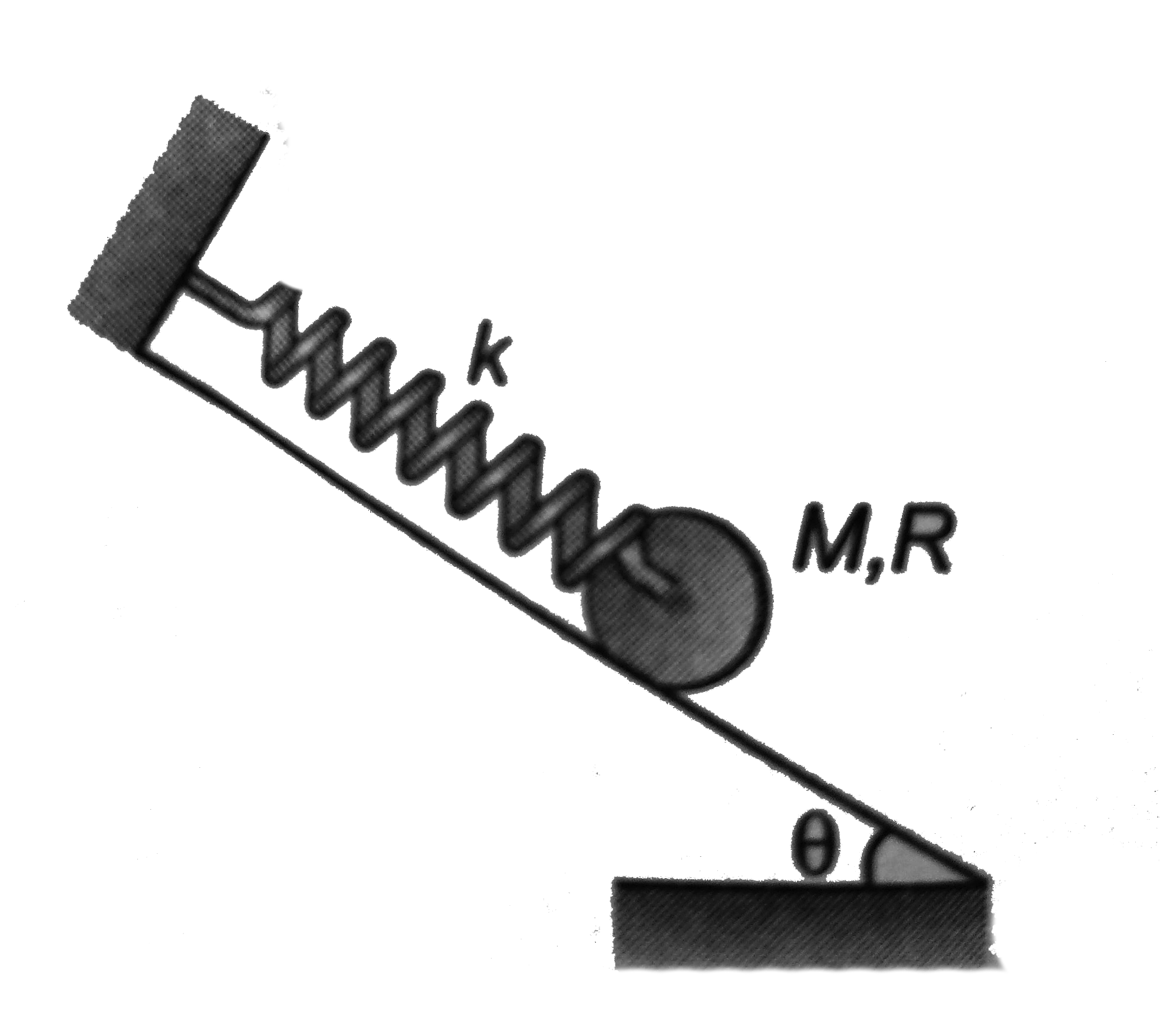A cylinder is released from rest from the top of an incline of inclination θ and length 'L'. If the cylinder rolls without slipping. What will be its speed when it reaches the bottom?
To find the speed of the cylinder when it reaches the bottom of the incline, we can use the principle of conservation of energy. Here’s a step-by-step solution:
Step 1: Identify the initial and final energies
- At the top of the incline, the cylinder has gravitational potential energy (PE) and no kinetic energy (KE) since it starts from rest.
- At the bottom of the incline, the potential energy is zero, and the cylinder has both translational and rotational kinetic energy.
Step 2: Calculate the initial potential energy
- The height (h) from which the cylinder is released can be calculated using the length of the incline (L) and the angle of inclination (θ):
h=Lsin(θ)
- The potential energy at the top is given by:
PE=mgh=mgLsin(θ)
Step 3: Write the expression for kinetic energy at the bottom
- The kinetic energy (KE) at the bottom consists of translational kinetic energy and rotational kinetic energy:
KE=12mv2+12Iω2
- For a solid cylinder, the moment of inertia (I) is:
I=12mr2
- The relationship between linear velocity (v) and angular velocity (ω) for rolling without slipping is:
v=rω⇒ω=vr
- Substituting for I and ω in the kinetic energy equation gives:
KE = \frac{1}{2} mv^2 + \frac{1}{2} \left(\frac{1}{2} m r^2\right \left(\frac{v}{r}\right)^2
- Simplifying this, we have:
KE=12mv2+14mv2=34mv2
Step 4: Set potential energy equal to kinetic energy
- According to the conservation of energy:
PE=KE
mgLsin(θ)=34mv2
Step 5: Solve for v
- Cancel m from both sides:
gLsin(θ)=34v2
- Rearranging gives:
v2=43gLsin(θ)
- Taking the square root:
v=√43gLsin(θ)
Final Answer
The speed of the cylinder when it reaches the bottom of the incline is:
v=√43gLsin(θ)
- At the top of the incline, the cylinder has gravitational potential energy (PE) and no kinetic energy (KE) since it starts from rest.
- At the bottom of the incline, the potential energy is zero, and the cylinder has both translational and rotational kinetic energy.
- The height (h) from which the cylinder is released can be calculated using the length of the incline (L) and the angle of inclination (θ):
h=Lsin(θ)
- The potential energy at the top is given by:
PE=mgh=mgLsin(θ)
- The kinetic energy (KE) at the bottom consists of translational kinetic energy and rotational kinetic energy:
KE=12mv2+12Iω2
- For a solid cylinder, the moment of inertia (I) is:
I=12mr2
- The relationship between linear velocity (v) and angular velocity (ω) for rolling without slipping is:
v=rω⇒ω=vr
- Substituting for I and ω in the kinetic energy equation gives:
KE = \frac{1}{2} mv^2 + \frac{1}{2} \left(\frac{1}{2} m r^2\right \left(\frac{v}{r}\right)^2
- Simplifying this, we have:
KE=12mv2+14mv2=34mv2
- According to the conservation of energy:
PE=KE
mgLsin(θ)=34mv2
- Cancel m from both sides:
gLsin(θ)=34v2
- Rearranging gives:
v2=43gLsin(θ)
- Taking the square root:
v=√43gLsin(θ)
The speed of the cylinder when it reaches the bottom of the incline is:
v=√43gLsin(θ)
Topper's Solved these Questions
- ROTATIONAL MECHANICSBOOK - HC VERMA ENGLISHCHAPTER - ROTATIONAL MECHANICSEXERCISE - Objective -1
26 Videos
- ROTATIONAL MECHANICSBOOK - HC VERMA ENGLISHCHAPTER - ROTATIONAL MECHANICSEXERCISE - Objective -2
14 Videos
- ROTATIONAL MECHANICSBOOK - HC VERMA ENGLISHCHAPTER - ROTATIONAL MECHANICSEXERCISE - Questions for short Answer
21 Videos
- REST AND MOTION : KINEMATICSBOOK - HC VERMA ENGLISHCHAPTER - REST AND MOTION : KINEMATICSEXERCISE - Question for short Answer
13 Videos
- SIMPLE HARMONIC MOTIONBOOK - HC VERMA ENGLISHCHAPTER - SIMPLE HARMONIC MOTIONEXERCISE - Question for short Answer
15 Videos
Similar Questions
Knowledge Check
A solid cylinder of mass M and radius R rolls down an inclined plane without slipping. THE speed of its centre of mass when it reaches the bottom is
A√(2gh)B√4/3.ghC√3/4.ghD√(4g/h)A solid cylinder rolls up an inclined plane of inclination θ with an initial velocity v. How far does the cylinder go up the plane ?
A3v22gsinθBv24gsinθC3v2gsinθD3v24gsinθ
Two objects, a ring and a spherical shell of same mass and radius are released from the top of two Identical inclined plane. If they are rolling without slipping, then ratio of speed of center of mass of the two objects when they will reach the bottom of the inclined plane is
View SolutionA solid cylinder of mass M and radius R rolls down an inclined plane of height h without slipping. The speed of its centre when it reaches the bottom is.
View SolutionA solid cylinder and a solid sphere, both having the same mass and radius, are released from a rough inclined plane of inclination θ one by one. They roll on the inclined plane without slipping. The force of friction that acts
View Solution
A uniform cylinder of mass M and radius R is released from rest on a rough inclined surface of inclination θ with the horizontal as shown in figure. As the cylinder rolls down the inclined surface, the maximum elongation it the spring stiffness k is
View SolutionTwo uniform solid spheres having unequal radii are released from rest from the same height on a rough incline. If the spheres roll without slipping
View SolutionA ring starts to roll down the inclined plane of height h without slipping . The velocity when it reaches the ground is
View Solution
